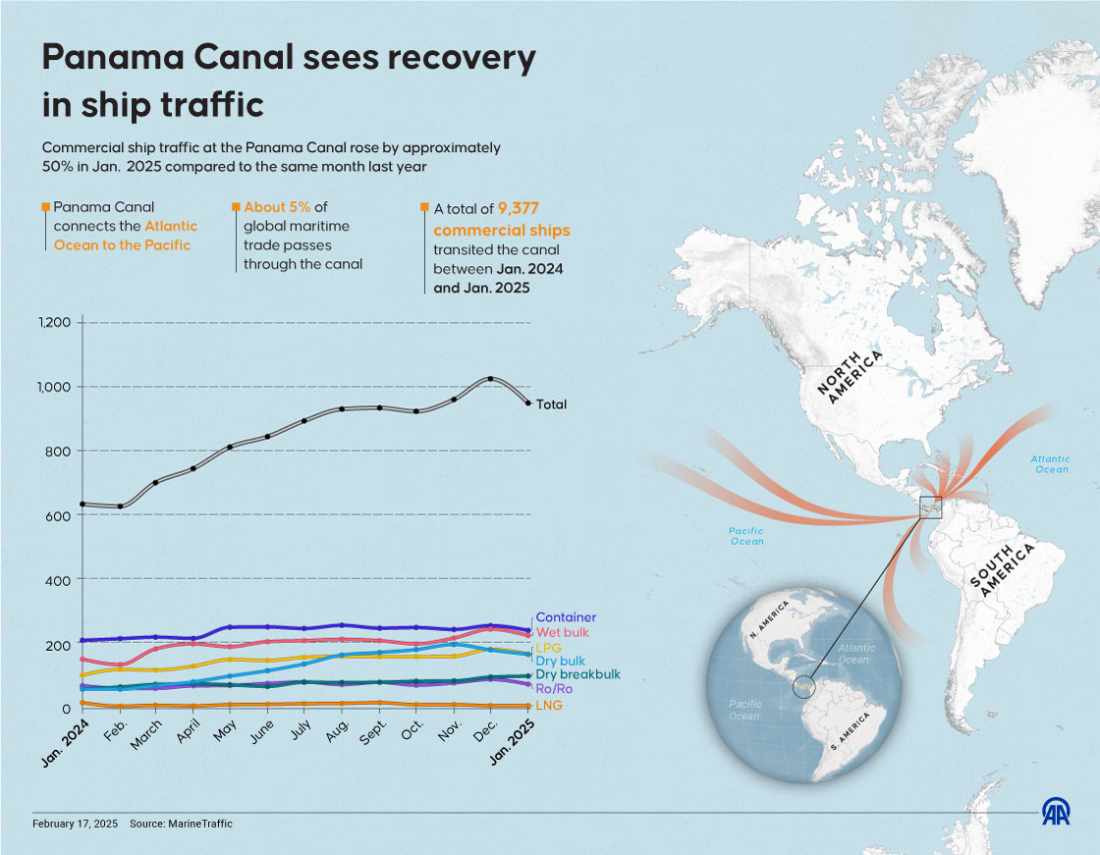Trump sues BBC for $10 billion over edited 6 January speech
President Donald Trump has filed a defamation lawsuit against the BBC over edited footage of a speech that made it appear he encouraged supporters to ...
Panama City, Panama, February 18, 2025 – Vessel traffic through the Panama Canal rebounded significantly in January, with data showing an almost 50% year-on-year increase.
Eased weather conditions and improved draught levels have contributed to a recovery in transits, as 632 commercial vessels passed through the strategic waterway daily, bringing the total to 9,377 for January 2024-25.
The recovery was marked by notable increases across several vessel categories. Container ship traffic rose 15%, while liquid bulk cargo vessels increased by 50% to 221 transits. Dry breakbulk cargo shipments saw a surge of 205%, reaching 162 transits. In contrast, LNG traffic declined slightly by 2%, with 11 LNG ships recorded—a downturn linked to shifting energy supply patterns following Europe’s pivot toward US LNG amid ongoing geopolitical tensions.
Despite these gains, overall vessel traffic remains below the 2019–2022 average, as the canal continues to navigate challenges posed by climate-related fluctuations in water levels.
The canal, which serves as a vital link between the Atlantic and Pacific Oceans and ranks as the world’s second largest trade route with over 10,000 annual transits, remains predominantly used by the United States, accounting for 52% of ship traffic. Other major users include China - handling roughly a quarter of US cargo - along with Chile, Japan, and South Korea.

In a separate development, former US President Donald Trump made headlines by suggesting that the United States might consider reclaiming control of the canal. During a press conference, Trump remarked, “We didn’t give it to China. We gave it to Panama, and Panama has been ripping down all the Chinese language signs,” adding that the US should take action. His comments come amid broader discussions about Chinese influence in global trade routes, although the Panama Canal has been under Panamanian control since 1999 following a series of agreements that transferred US operational rights over the years.
Originally constructed under the Roosevelt administration and operated by the United States until a joint management arrangement began in 1977, the canal was fully handed over to Panama in 1999. Trump’s remarks have sparked controversy, as the canal’s governance and sovereignty are well established under Panamanian law.
As the canal’s vessel traffic continues to recover, analysts note that while weather-related challenges are easing, the long-term impact of climate change on canal operations remains a key concern for global trade stakeholders.
Russia’s human rights commissioner, Tatyana Moskalkova, has said that Ukraine has not provided Moscow with a list of thousands of children it alleges were taken illegally to Russia, despite the issue being discussed during talks in Istanbul.
An explosive device found in a vehicle linked to one of the alleged attackers in Bondi shooting has been secured and removed according to Police. The incident left 12 people dead.
Syrian President Ahmad al-Sharaa has offered condolences to President Donald Trump following an ISIS attack near the ancient city of Palmyra that killed two U.S. soldiers and a civilian interpreter, Syrian and U.S. officials said Sunday.
At least 17 people, including students, were killed and 20 others injured after a school bus fell off a cliff in northern Colombia on Sunday, authorities said.
At least 14 people have died and 32 others were injured after flash floods swept through Morocco’s Atlantic coastal city of Safi on Sunday, authorities said.
President Donald Trump has filed a defamation lawsuit against the BBC over edited footage of a speech that made it appear he encouraged supporters to storm the U.S. Capitol 6 January 2021, marking an international extension of his ongoing battle against media coverage he deems inaccurate or biased.
Ford Motor Company said on Monday it will take a $19.5 billion writedown and scrap several electric vehicle (EV) models, marking a major retreat from its battery-powered ambitions amid declining EV demand and changes under the Trump administration.
Schools across Cambodia and Thailand were forced to close on Monday as border clashes between the two countries escalated, with the death toll reaching at least 40 and hundreds of thousands of people displaced, according to officials and local media.
Police in Providence are going door to door for home surveillance footage as the hunt continues for the shooter who killed two Brown University students and injured seven others. Authorities have released fresh video and say a detained "person of interest" is now free.
Ukrainian President Volodymyr Zelenskyy engaged in high-level talks in Berlin from 14-15 December, with German Chancellor Friedrich Merz, U.S. envoys, and European leaders, focusing on security guarantees and the framework for a potential peace deal with Russia.
You can download the AnewZ application from Play Store and the App Store.

What is your opinion on this topic?
Leave the first comment